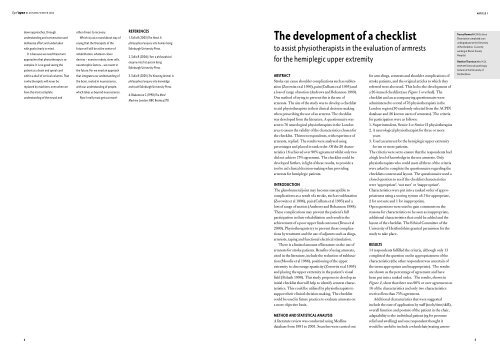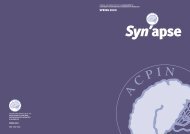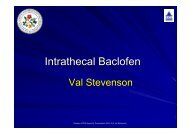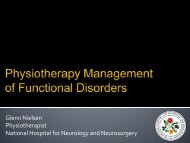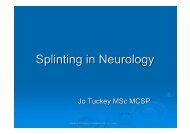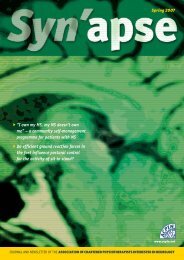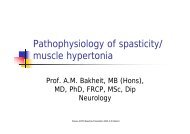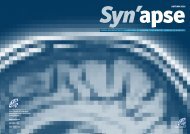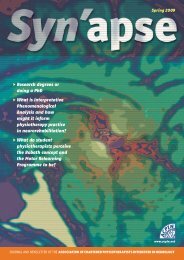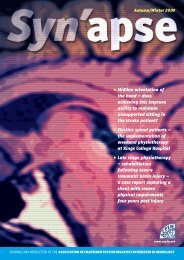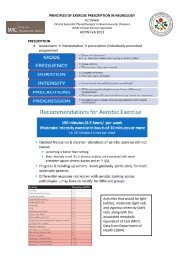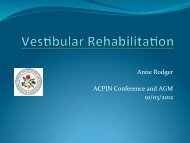Synapse AUTUMN 2004 - acpin
Synapse AUTUMN 2004 - acpin
Synapse AUTUMN 2004 - acpin
Create successful ePaper yourself
Turn your PDF publications into a flip-book with our unique Google optimized e-Paper software.
Syn’apse ● <strong>AUTUMN</strong>/WINTER <strong>2004</strong><br />
ARTICLE 1<br />
down approaches, through<br />
understanding and conversation and<br />
deliberate effort and undertaken<br />
with goals clearly in mind.<br />
It is because we need these twin<br />
approaches that physiotherapy is so<br />
complex. It is no good seeing the<br />
patient as a brain and spinal cord<br />
within a skull of vertical columns. That<br />
is why therapists will never be<br />
replaced by machines, even when we<br />
have the most complete<br />
understanding of the neural and<br />
other drivers to recovery.<br />
Which is just a round about way of<br />
saying that the therapists of the<br />
future will still be at the centre of<br />
rehabilitation, whatever clever<br />
devices – exercise robots, stem cells,<br />
neurotrophic factors – we invent in<br />
the future. For we need an approach<br />
that integrates our understanding of<br />
the brain, rooted in neuroscience,<br />
with our understanding of people,<br />
which takes us beyond neuroscience.<br />
Now I really must get out more!<br />
REFERENCES<br />
1. Tallis R (2003) The Hand. A<br />
philosophical enquiry into human being.<br />
Edinburgh University Press.<br />
2. Tallis R (<strong>2004</strong>) I Am: a philosophical<br />
enquiry into first-person being<br />
Edinburgh University Press.<br />
3. Tallis R (2005) The Knowing Animal. A<br />
philosophical enquiry into knowledge<br />
and truth Edinburgh University Press.<br />
4. Blakemore C (1990) The Mind<br />
Machine London: BBC Books p270.<br />
The development of a checklist<br />
to assist physiotherapists in the evaluation of armrests<br />
for the hemiplegic upper extremity<br />
ABSTRACT<br />
Stroke can cause shoulder complications such as subluxation<br />
(Zorowitz et al 1996), pain (Culham et al 1995) and<br />
a loss of range of motion (Andrews and Bohannon 1989).<br />
One method of trying to prevent this is the use of<br />
armrests. The aim of the study was to develop a checklist<br />
to aid physiotherapists in their clinical decision-making<br />
when prescribing the use of an armrest. The checklist<br />
was developed from the literature. A questionnaire was<br />
sent to 76 neurological physiotherapists in the London<br />
area to assess the validity of the characteristics chosen for<br />
the checklist. Thirteen respondents, with experience of<br />
armrests, replied. The results were analysed using<br />
percentages and placed in rank order. Of the 26 characteristics<br />
16 achieved over 90% agreement whilst only two<br />
did not achieve 75% agreement. The checklist could be<br />
developed further, in light of these results, to provide a<br />
tool to aid clinical decision-making when providing<br />
armrests for hemiplegic patients.<br />
INTRODUCTION<br />
The glenohumeral joint may become susceptible to<br />
complications as a result of a stroke, such as subluxation<br />
(Zorowitz et al 1996), pain (Culham et al 1995) and a<br />
loss of range of motion (Andrews and Bohannon 1989).<br />
These complications may prevent the patient’s full<br />
participation in their rehabilitation and result in the<br />
achievement of a poor upper limb outcome (Dean et al<br />
2000). Physiotherapists try to prevent these complications<br />
by treatment and the use of adjuncts such as slings,<br />
armrests, taping and functional electrical stimulation.<br />
There is a limited amount of literature on the use of<br />
armrests for stroke patients. Benefits of using armrests,<br />
cited in the literature, include the reduction of subluxation<br />
(Moodie et al 1986), positioning of the upper<br />
extremity to discourage spasticity (Zorowitz et al 1995)<br />
and placing the upper extremity in the patient’s visual<br />
field (Bobath 1990). This study proposes to develop an<br />
initial checklist that will help to identify armrest characteristics.<br />
This could be utilised by physiotherapists to<br />
support their clinical decision-making. The checklist<br />
could be used in future practice to evaluate armrests on<br />
a more objective basis.<br />
METHOD AND STATISTICAL ANALYSIS<br />
A literature review was conducted using Medline<br />
database from 1991 to 2001. Searches were carried out<br />
for arm slings, armrests and shoulder complications of<br />
stroke patients, and the original articles to which they<br />
referred were also used. This led to the development of<br />
a 26-itemed checklist (see Figure 1 overleaf). The<br />
checklist and an accompanying questionnaire were<br />
administered to a total of 76 physiotherapists in the<br />
London region (50 randomly selected from the ACPIN<br />
database and 26 known users of armrests). The criteria<br />
for participation were as follows:<br />
1. Superintendent, Senior I or Senior II physiotherapist<br />
2. A neurological physiotherapist for three or more<br />
years<br />
3. Used an armrest for the hemiplegic upper extremity<br />
for ten or more patients.<br />
The criteria were set to ensure that the respondents had<br />
a high level of knowledge in the use armrests. Only<br />
physiotherapists who could meet all three of the criteria<br />
were asked to complete the questionnaire regarding the<br />
checklists content and layout. The questionnaire used a<br />
closed question to see if the checklist characteristics<br />
were ‘appropriate’, ‘not sure’ or ‘inappropriate’.<br />
Characteristics were put into a ranked order of appropriateness<br />
using a scoring system of: 3 for appropriate,<br />
2 for not sure and 1 for inappropriate.<br />
Open questions were used to gain comments on the<br />
reasons for characteristics to be seen as inappropriate,<br />
additional characteristics that could be added and the<br />
layout of the checklist. The Ethical Committee of the<br />
University of Hertfordshire granted permission for the<br />
study to take place.<br />
RESULTS<br />
14 respondents fulfilled the criteria, although only 13<br />
completed the question on the appropriateness of the<br />
characteristics (the other respondent was uncertain of<br />
the terms appropriate and inappropriate). The results<br />
are shown as the percentage of agreement and have<br />
been put into a ranked order. The results, shown in<br />
Figure 2, show that there was 90% or over agreement on<br />
16 of the characteristics and only two characteristics<br />
received less than 75% agreement.<br />
Additional characteristics that were suggested<br />
include the ease of application by staff (tools/time/skill),<br />
overall function and posture of the patient in the chair,<br />
adaptability to the individual patient (eg for pressure<br />
relief and swelling) and one respondent thought it<br />
would be useful to include a wheelchair/seating assess-<br />
Tracey Howard MCSP BSc (Hons)<br />
Dissertation completed as an<br />
undergraduate at the University<br />
of Hertfordshire. Currently<br />
working at Dorset County<br />
Hospital.<br />
Heather Thornton MBA, PGCE,<br />
MCSP, SRP, Senior physiotherapy<br />
lecturer at the University of<br />
Hertfordshire.<br />
4<br />
5


